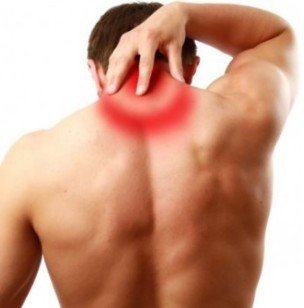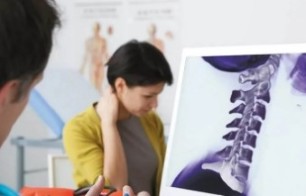Osteochondrosis is a disease of the spine, which is characterized by the development of changes in the cartilage of the intervertebral discs, and the process of surrounding tissues.
Osteochondrosis cervical spine differs in its manifestations thoracic and lumbar degenerative disc disease. The symptoms of cervical arthritis related to anatomical characteristics of the cervical spine. The dimensions of the vertebrae of the cervical spine less than the size of the other divisions. Cervical constantly tests the load, hold the head, and in this it is distinguished by great mobility.

Causes of disc degeneration
The causes of the evolution of the disease in the first place are the age, the ageing of the body and of the evolution of the destruction of the bone and cartilage. You can also call the causes of the degenerative disease of the disc:
- the violation of posture,
- reduction in physical activity resulting from a sedentary lifestyle,
- excess weight, which is the result of the violation of metabolism, exerts a pressure on the intervertebral discs,
- a hereditary factor
- long-term physical exercise,
- the abnormalities of the spine.
Uniform of the physical load, a good diet and a healthy lifestyle significantly reduces the likelihood of development of this disease, as well as reducing the impact on the overall health.
The symptoms of cervical arthritis of the spine
The manifestations of the cervical osteoarthritis differ in symptoms in the other departments of the vertebral column. This is related to the fact that the cervical vertebrae have a different structure and are very close to each other. Therefore, any offset manifested by intense pain. In addition, in the cervical region of the spine is often zaselyalsya nerve center of the clump and the arteries.
Cervical osteochondrosis of the spine is manifested by the following symptoms:
- The sensation of pain – the pain can be felt in different parts of the body. This is due to what is going pinched nerve endings and muscles of the corresponding part of the body.
- A weakness in the upper limbs – is manifested because of the crushing of the nerve endings responsible for motor activity.
- The complexity during rotations of the head, the appearance of the cracking of the vertebrae of the cervical spine – occurs due to changes in the structure of disc herniation, the onset of training.
- The low sensitivity of the hand.
- The weakness and dizziness appear because of the crushing of the artery, which ensures the supply of blood and nutrition into the brain.
- Decline in hearing and sight – appears on the last phase of the disease, when the circulation disorders in the cerebellum.
The signs of degenerative disc disease of the cervical spine
- Radicular syndrome is characterized by a pinched nerve of the beam in the region of the neck. Is manifested by severe pain, which can be estimated from the shoulder to the shoulder blade.
- Vertebral syndrome manifests itself more severe headache, pain in the temples and the nape of the neck.
- The reflex syndrome characterized by severe pain in the cervical region, which may accompany the movement of the head. The pain can move into the shoulder and chest.
- Cardinal syndrome think of a crisis of angina pectoris, to determine which is extremely difficult.
The degree of development of the osteoarthritis of the cervical spine
In the course of their development of the disease goes through several stages. Each stage has its own characteristics and is characterized by certain signs.
- Phase 1. Musculoskeletal-cartilage tissue, vertebrae begins to fall in ruins. The symptoms of the disease are not very visible. And very often, patients do not notice them, and combine fatigue and pain with fatigue and stress.
- 2 the stage. The height of the disc begins to decrease, there are cracks. The patient is experiencing persistent pain, weakness, numbness of the face.
- 3 the stage. Begin to form, herniated discs, damaged scarves the blood vessels and muscles. Complaints appear on the dizziness, pain in the nape of the neck.
- Stage 4. The bone tissue, which protects the vertebrae of the excess load, begins to grow, after which zaselyalsya the nerve endings. There is the stiffness in the movements, damage to the adjacent joints.
The dangers of cervical osteoarthritis
In the cervical region, you will find many nerves and arteries that supply the brain can understand. In the case of a violation of their work, the brain will not get enough power for a normal operation. This situation may disrupt the motor activity of man, cause of pain in the limbs, and loss of coordination.
End-stage degenerative disease of the disk may develop ischemia, stroke, and many other diseases dangerous to the life of man.
Therefore, at the onset of the symptoms associated with this disease, it is recommended to consult a doctor.
The diagnosis of the cervical spine
For reviews of diseases of the spine are the following types of diagnostics:
- the x-ray – is an effective way for diagnosis of this disease,
- MRI (magnetic resonance imaging)shows the bone structure, formed of a disc herniation and their dimensions,
- CT (computed tomography) is inefficient compared to the MRI, because with the help of this method of diagnosis is difficult to determine the size of the hernia,
- Ultrasound duplex scanning is used in the case where disturbed blood circulation in general. This survey shows existing of the speed of blood flow, as well as the presence of obstacles in its path.
The treatment of the osteoarthritis of the cervical spine

The treatment of the osteoarthritis of the cervical spine should be performed in the complex depending on the situation. The positive effect, you can get through a full management and an individual approach, which includes a drug therapy, physio of the procedure, healing of the physical education, massage treatments, are also used for traditional medicine.
During exacerbation treatment of osteoarthritis of the cervical spine is intended to improve the blood circulation of the libration of muscle spasms. In this case, are assigned to tools that improve the blood circulation, anti-inflammatory and analgesic, a vitamin complex.
Physiotherapy low back pain cervical
Gymnastics, curative gives visible results and less dangerous in the healing phase. The principle of action of physical therapy is to restore the blood circulation in the parts of the body. By doing physiotherapy exercises the patient should not feel the pain and the inconvenience.
A series of exercises for the cervical spine is designed to strengthen the muscles of the neck, and also plays the role of the prevention for the development of cervical osteoarthritis.
Massage in osteochondrosis of the cervical spine
The massage is done in order to strengthen the tone in the muscles and relieve the pain. Depending on the stage of development of the disease are the various methods of massage. The classic receptions of massage are:
- scrubbing – this technique is the impact on the superficial layers of the skin. Begin the massage of the area and continues to clavicula and underarms.
- squat – in this case, the impact of the massage course is happening on the deeper layers of the skin. Through the neck between the thumb and the index carry out a movement to seize the skin that look like the pump.
- the crushing – is done with the purpose of warming up and relaxation of the skin to improve the blood circulation in the cervical region of the spine.
- kneading – has limits, because it profoundly affects tissue behind. During the poor execution of this reception may harm the patient.
In these cases, when the patient has the feeling of pain occurs with a single hand, the massage should be to begin with a good part of the neck, gradually moving in the part of the cervical spine, where you can see the pain.
The massage can be done at home and in a health institution. However, during its execution, you must be very careful not to provoke the aggravation of the disease or not to make it worse.
The prevention of the occurrence of cervical osteoarthritis
To prevent the occurrence and development of disease, it is recommended to follow some simple rules:
- lead a healthy life, exercise regularly, access to the swimming pool;
- diversify the diet of foods rich in magnesium and calcium;
- in the cases where the work is sedentary, it is necessary several times a day to the training;
- for the sleep, it should be to choose a foam mattress and a comfortable cushion.

















